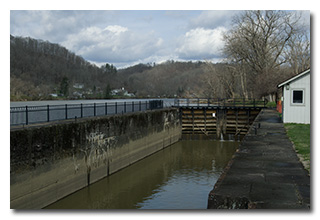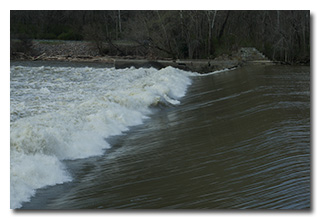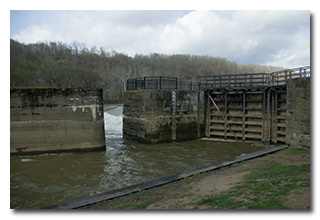
by William Eric McFadden
From the park's website:
-
The Muskingum River Parkway State Park has been placed on the National Register of Historic Places and is recognized as the Muskingum River Navigation Historic District. In its day, the system of locks and dams helped open the state and the entire Midwest to trade and development. It is the only remaining system of hand-operated locks in the nation.
The locks help boats safely bypass ten dams on the Muskingum River from Zanesville south to the Ohio River at Marietta. These locks are operated at no charge for recreational boats. Ten of the eleven locks still function— the northernmost lock, Ellis #11, is no longer in operation but offers a campground. The remaining locks have a variety of amenities and many communities along the Muskingum River offer recreational and sight-seeing opportunities for boaters and non-boaters alike. Visitors may enjoy watching the river from the park's picnic shelter south of Lock #7 on State Route 376.
From the Muskingum River Water Trail map and brochure:
-
The Rokeby dam was constructed between 1837 and 1841. A plaque at the site commemorates the lock and dam system as a National Historic Civil Engineering Landmark. Imagine floating downriver during the summer of 1863 when Morgan’s Raiders, a group of Confederate soldiers, crossed the Muskingum River in this vicinity. This was the northernmost movement of Confederate troops in the Civil War. Civil War reenactments are celebrated annually in the area.
Pictures
Description
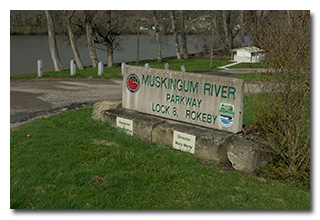 On Friday, April 8, 2022, one member of the Southeast Ohio Radio Adventure Team
performed a successful activation of Muskingum River State Park in Ohio as part of the Parks on the
Air (POTA; link) program.
On Friday, April 8, 2022, one member of the Southeast Ohio Radio Adventure Team
performed a successful activation of Muskingum River State Park in Ohio as part of the Parks on the
Air (POTA; link) program.
Having decided that his goal within POTA for the next few months would be to earn the Oasis Repeat Offender Activator Award for Muskingum River State Park by visiting all ten of the river-navigation locks and dams that make up the state park, Eric McFadden, WD8RIF, returned to Rokeby Lock and Dam #8 on a cool, gray day that threatened rain, arriving at the lock at about 1415 UTC. Eric was accompanied by his little dog Theo.
This was to be Eric's fifteenth activation of Muskingum River State Park, with his previous activations having occurred at...
- Devola Lock #2 (2022-02-18 / 2022-03-11),
- Lowell Lock #3 (2022-02-25 / 2022-03-18),
- Beverly Lock #4 (2022-03-25),
- Luke Chute Lock #5 (2022-02-19 / 2022-04-01),
- Stockport Lock #6 (2018-09-15 / 2021-05-29),
- McConnelsville Lock #7 (2022-02-21),
- Rokeby Lock #8 (2021-02-27),
- Philo Lock #9 (2022-03-04),
- Zanesville Lock #10 (2021-07-23), and
- Ellis Lock #11 (2022-03-06).
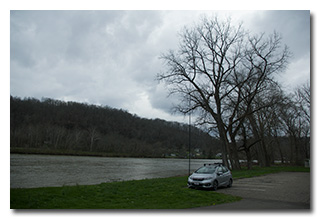 Finding the parking area empty upon his arrival, Eric parked the car, walked Theo, took photos,
and deployed his 28½' wire vertical on a Jackite 31' telescoping fiberglass mast and drive-on mount and, because of
the threat of rain, he set up his KX3 inside the car. Eric was on the air at 1433 UTC.
Finding the parking area empty upon his arrival, Eric parked the car, walked Theo, took photos,
and deployed his 28½' wire vertical on a Jackite 31' telescoping fiberglass mast and drive-on mount and, because of
the threat of rain, he set up his KX3 inside the car. Eric was on the air at 1433 UTC.
At his previous visit to Rokeby Lock and Dam #8, Eric had found he had poor cell-signal, so he was surprised this time to find he had good enough cell-signal to allow him to spot himself on POTA Spots (link) and to use POTA Spots to identify possible park-to-park (P2P) QSO opportunities. Because he hadn't expected to have cell-signal, Eric had previously announced his activation on POTA Spots and had arranged for his friends K8RAT and K4SWL to watch for him on the Reverse Beacon Network (RBN, link).
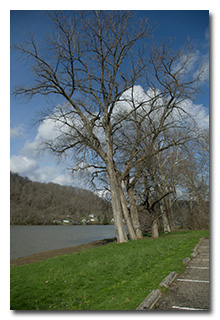 Eric began operations on 40m by finding a frequency to run, calling "CQ POTA", and spotting himself to POTA Spots.
Eric's first QSO came at 1436 UTC with WB3AVD in Pennsylvania. QSOs came steadily, with Eric's twenty-second QSO coming at 1458 UTC
with KB8OOM in Ohio. This run included a QSO with Eric's good friend K8RAT and QSOs with operators located in Pennsylvania (2),
Ohio (4), North Carolina (2), Indiana (2), Illinois (2), Tennessee (5), Alabama, West Virginia, Kentucky, Wisconsin, and
Ontario.
Eric began operations on 40m by finding a frequency to run, calling "CQ POTA", and spotting himself to POTA Spots.
Eric's first QSO came at 1436 UTC with WB3AVD in Pennsylvania. QSOs came steadily, with Eric's twenty-second QSO coming at 1458 UTC
with KB8OOM in Ohio. This run included a QSO with Eric's good friend K8RAT and QSOs with operators located in Pennsylvania (2),
Ohio (4), North Carolina (2), Indiana (2), Illinois (2), Tennessee (5), Alabama, West Virginia, Kentucky, Wisconsin, and
Ontario.
Following the run on 40m, the rain appeared to be moving in, so Eric chose to tear down his station before it arrived and drive to his next park.
In all, Eric made twenty-two QSOs in about twenty-five minutes. All of Eric's QSOs were CW and were made with five watts output.
Eric also submitted his log to the World Wide Flora and Fauna in Amateur Radio (WWFF; link) program.
(return)
